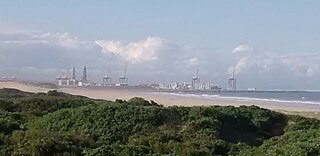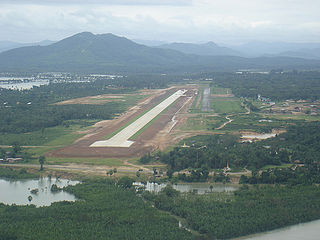
The economy of Kazakhstan is the largest in Central Asia in both absolute and per capita terms. In 2021, Kazakhstan attracted more than US$370 billion of foreign investments since becoming an independent republic after the collapse of the former Soviet Union.
A special economic zone (SEZ) is an area in which the business and trade laws are different from the rest of the country. SEZs are located within a country's national borders, and their aims include increasing trade balance, employment, increased investment, job creation and effective administration. To encourage businesses to set up in the zone, financial policies are introduced. These policies typically encompass investing, taxation, trading, quotas, customs and labour regulations. Additionally, companies may be offered tax holidays, where upon establishing themselves in a zone, they are granted a period of lower taxation.
A free-trade zone (FTZ) is a class of special economic zone. It is a geographic area where goods may be imported, stored, handled, manufactured, or reconfigured and re-exported under specific customs regulation and generally not subject to customs duty. Free trade zones are generally organized around major seaports, international airports, and national frontiers—areas with many geographic advantages for trade.
Xiamen Special Economic Zone, established in October 1980, is one of the five special economic zones in the People's Republic of China. Originally comprising a territory of 2.5 km2 in Xiamen City, it was expanded to 131 km2 in 1984, covering the entire Xiamen Island, which comprises Huli District and Siming District excluding Gulangyu.

An industrial park, also known as industrial estate or trading estate, is an area zoned and planned for the purpose of industrial development. An industrial park can be thought of as a more heavyweight version of a business park or office park, which has offices and light industry, rather than heavy industry. Industrial parks are notable for being relatively simple to build; they often feature speedily erected single-space steel sheds, occasionally in bright colours.
In justifying opening up and the series of economic reforms that ensued in China, Deng Xiaoping referred to Karl Marx and his theories, which predicted that nations need to undergo urbanization and a stage of capitalism for a natural socialist transition. One of the most renowned reforms under Deng was establishing four "special economic zones" along the Southeastern coast of China, with Shenzhen, Shantou, and Zhuhai located in Guangdong province and Xiamen located in Fujian province. Special economic zones (SEZs) in mainland China are granted more free market-oriented economic policies and flexible governmental measures by the government of China, compared to the planned economy elsewhere.

Atlantis is a town in the Western Cape province of South Africa and is 40 km (25 mi) north of the Cape Town. As of 2011, it has 67,491 residents. Unemployment, lack of housing and crime are major challenges in the area.
An urban enterprise zone is an area in which policies to encourage economic growth and development are implemented. Urban enterprise zone policies generally offer tax concessions, infrastructure incentives, and reduced regulations to attract investments and private companies into the zones. They are a type of special economic zone where companies can locate free of certain local, state, and federal taxes and restrictions. Urban enterprise zones are intended to encourage development in deprived neighborhoods through tax and regulatory relief to entrepreneurs and investors who launch businesses in the area.
The Rason Special Economic Zone, earlier called the Rajin-Sonbong Economic Special Zone, was established in the early 1990s by the North Korean government near Rason to promote economic growth through foreign investment. It is similar to the Special Economic Zones set up by the People's Republic of China and elsewhere to pilot market economics in a designated controlled area. It is near the border with China and Russia and is a warm-water port for both countries.

The Coega Special Economic Zone (SEZ), established in 1999 and 9 003 ha in extent, is situated near Gqeberha in the Eastern Cape province of South Africa. The initiative is a multibillion-dollar industrial development complex customised for heavy, medium and light industries, and adjacent to a deep-water port, the Port of Ngqura. The Coega Development Corporation (CDC) is the developer and operator of the Coega SEZ and is responsible for the land side infrastructure, while the Transnet National Ports Authority (TNPA) develops the deep-water port facility, the Port of Ngqura.
The Liepaja Special Economic Zone is the only special economic zone in the Baltics consisting of a seaport, industrial area and international airport. Liepāja special economic zone was established in 1997 to develop port operations, cargo handling, logistics, manufacturing and air transportation. The goal of the Liepāja SEZ is to attract investments for the development of the port, manufacturing, and creating new working places.

Foreign direct investment in Iran (FDI) has been hindered by unfavorable or complex operating requirements and by international sanctions, although in the early 2000s the Iranian government liberalized investment regulations. Iran ranks 62nd in the World Economic Forum's 2011 analysis of the global competitiveness of 142 countries. In 2010, Iran ranked sixth globally in attracting foreign investments.
Santacruz Electronics Export Processing Zone (SEEPZ) is a Special Economic Zone in Mumbai, India. Situated in the Andheri East area, it is subjected to liberal economic laws as compared to the rest of India to promote rapid economic growth using tax and business incentives and attract foreign investment and technology. Seepz was created in 1973 and was seen as export processing zone. Since then many other SEZ's have been created in rest of India. SEEPZ mainly houses electronic hardware manufacturing companies, software companies, and jewelry exporters of India. More than 40 percent of India's total jewelry exports ($2,222.31 million) out of $5,210.69 million during year 2006-2007 came from units within SEEPZ.

Gujarat International Finance Tec-City is a central business district under construction in Gandhinagar district in Gujarat, India. It is India's first operational greenfield smart city and international financial services centre, which the Government of Gujarat promoted as a greenfield project. In 2020 GIFT IFSC bagged 10th place in Finance Industry and top rank in emerging financial centres in Global Financial Centres Index. As of June 2023, it is home to 23 multi-national banks including HSBC, JP Morgan and Barclays; 35 fintech entities; two international stock exchanges with average daily trading volumes of $30.6 billion; as well as India's first international bullion exchange with 75 onboarded jewellers.

Alabuga is a special economic zone of an industrial and production type located in a 20 km² area in the Yelabuzhsky District of the Republic of Tatarstan in the Kama Innovative Territorial Production Cluster 10 km from Yelabuga, 25 km from Naberezhnye Chelny, 40 km from Nizhnekamsk and 210 km from the regional center — Kazan. The shareholders of the management company of the SEZ "Alabuga" are the Russian Federation through the JSC "Special Economic Zones" with 100% state participation (66%) and the Ministry of Land and Property of the Republic of Tatarstan (34%).

The Dawei deep-sea port and special economic zone is an infrastructure project in Burma. Construction started, but was suspended in 2013. Plans to resume construction were announced in August 2015. It is in Dawei, the capital of the Tanintharyi Region. It aims to transform Dawei into Myanmar's and Southeast Asia's largest industrial and trade zone. It aims to develop local businesses, provide local employment opportunities, and stimulate the construction of infrastructure. It is notable for its tumultuous history, as many financial and human rights violations have arisen during the project's history. If completed, it will be the largest industrial zone in Southeast Asia.
Madras Export Processing Zone (MEPZ) is a special economic zone in Chennai, India. It is one of the seven export processing zones in the country set up by the central government. It was established in 1984 to promote foreign direct investment, enhance foreign exchange earnings, and create greater employment opportunities in the region.

The Royal Science and Technology Park (RSTP) is a Swazi public enterprise and science park created to foster the conception of inventions and facilitate their patenting and help knit various elements of the R&D cluster together. It is intended to provide a focal point for research, facilitates the links between research and industrial communities and stimulates the development of knowledge-based businesses through the incubation of techno-preneurship and high-tech enterprises.

SEZ “Innopolis” is a high tech innovation hub located in the city of Innopolis in the Republic of Tatarstan. The Innopolis zone also bears the designation of a special economic zone (SEZ). On November 1, 2012 the Government of the Russian Federation issued a decree creating special territories to attract investment and develop the IT-industry in the region. A special economic zone provides its residents and partners with tax and customs benefits, insurance premiums, rental incentives and a number of other preferences.











